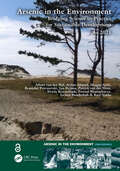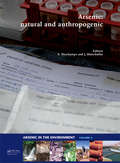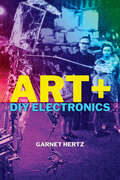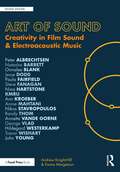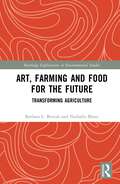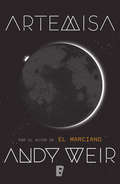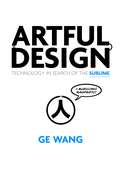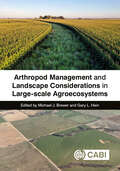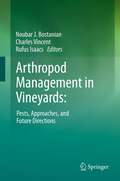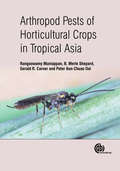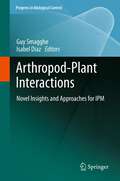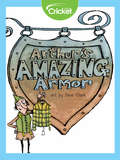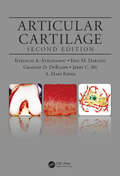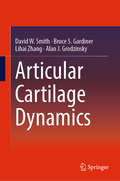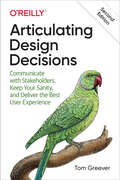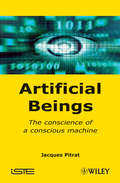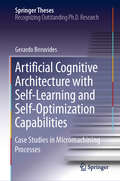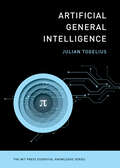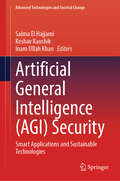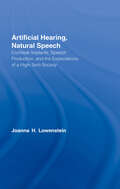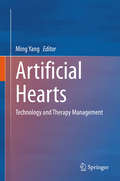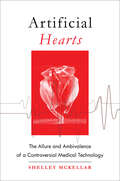- Table View
- List View
Arsenic in the Environment: Proceedings of the 8th International Congress and Exhibition on Arsenic in the Environment (As2021), June 7-9, 2021, Wageningen, The Netherlands (Arsenic in the Environment - Proceedings)
by Dragan Savic Jochen Bundschuh Prosun Bhattacharya Arslan Ahmad Ravi Naidu Branislav Petrusevski Jan Weijma Erwin Beerendonk van der Wal, Albert van der Wens, PatrickThe Congress and Exhibition Series "Arsenic in the Environment" offers an international, multi- and interdisciplinary discussion platform for research and innovation aimed towards a holistic solution to the challenges posed by the environmental toxin arsenic, with global societal impact. The Congress has focused on cutting edge and breakthrough research in physical, chemical, toxicological, medical, agricultural and other specific issues on arsenic across a broader environmental realm. The Biennial Congress and Exhibition "Arsenic in the Environment" was first organized in Mexico City (As2006) followed by As2008 in Valencia (Spain), As2010 in Tainan (Chinese Taiwan), As2012 in Cairns (Australia), As2014 in Buenos Aires (Argentina), As2016 in Stockholm (Sweden) and As2018 in Beijing (P.R. China).The 8th International Congress As2020 was held June 7-9, 2021 (first time digitally owing to the global COVID-19 pandemic, in Wageningen, The Netherlands) and with a title Arsenic in the Environment - Bridging Science to Practice for Sustainable Development. The Congress addressed the broader context of arsenic research aligned on the following themes:Theme 1: Arsenic in Natural Soil and Water SystemsTheme 2: Arsenic in Agriculture and Food ProductionTheme 3: Health Impacts of ArsenicTheme 4: Technologies for Arsenic Removal from WaterTheme 5: Sustainable Mitigation and Management for Sustainable DevelopmentArsenic in drinking water and food is a major health issue, affecting millions of people in many parts of the world. In recent years serious cases of arsenic exposure through different environmental matrices have been reported from, for example, Argentina, Bangladesh, Chile, China, Taiwan, Turkey, India, Mexico, UK, USA, Pakistan, Vietnam as well as other regions in the world. Arsenic can cause a number of carcinogenic and non-carcinogenic adverse effects on human health and therefore human exposure to arsenic should be avoided. Notably, The Netherlands has been in the forefront of research on arsenic removal technology and developed a cutting edge innovation to remove arsenic to levels below the WHO drinking water guideline to as low as less than 1 μg/L. This has created an enabling environment to discuss on policy issues for defining the new drinking water guideline. The Congress has attracted professionals involved in different segments of interdisciplinary research on arsenic in an open forum, and strengthened relations between academia, research institutions, government and non-governmental agencies, industries, and civil society organizations to share an optimal ambience for exchange of knowledge.
Arsenic: Natural and Anthropogenic (Arsenic in the environment)
by Jörg Matschullat Eleonora DeschampsThe discussion on arsenic in the environment is complex and must grasp the importance of very many, mostly unrelated works on individual aspects. This volume represents one of the first comprehensive and interdisciplinary examinations into arsenic's behaviour in air, water, soils, sediments, plants and the human body. Based on state-of-the-art investigations into the global arsenic cycle, the related human toxicology and available remediation technologies, arsenic is assessed holistically in all the environmental compartments. Using the results of primary research, the authors offer concrete suggestions for risk reduction and management of environmental pollution that allow the reader to successfully tackle similar problems and find sustainable solutions.
Art + DIY Electronics
by Garnet HertzA systematic theory of DIY electronic culture, drawn from a century of artists who have independently built creative technologies.Since the rise of Arduino and 3D printing in the mid-2000s, do-it-yourself approaches to the creative exploration of technology have surged in popularity. But the maker movement is not new: it is a historically significant practice in contemporary art and design. This book documents, tracks, and identifies a hundred years of innovative DIY technology practices, illustrating how the maker movement is a continuation of a long-standing creative electronic subculture. Through this comprehensive exploration, Garnet Hertz develops a theory and language of creative DIY electronics, drawing from diverse examples of contemporary art, including work from renowned electronic artists such as Nam June Paik and such art collectives as Survival Research Laboratories and the Barbie Liberation Front. Hertz uncovers the defining elements of electronic DIY culture, which often works with limited resources to bring new life to obsolete objects while engaging in a critical dialogue with consumer capitalism. Whether hacking blackboxed technologies or deploying culture jamming techniques to critique commercial labor practices or gender norms, the artists have found creative ways to make personal and political statements through creative technologies. The wide range of innovative works and practices profiled in Art + DIY Electronics form a general framework for DIY culture and help inspire readers to get creative with their own adaptations, fabrications, and reimaginations of everyday technologies.
Art of Digital Audio
by John WatkinsonDescribed as "the most comprehensive book on digital audio to date", it is widely acclaimed as an industry "bible". Covering the very latest developments in digital audio technology, it provides an thorough introduction to the theory as well as acting as an authoritative and comprehensive professional reference source. Everything you need is here from the fundamental principles to the latest applications, written in an award-winning style with clear explanations from first principles. New material covered includes internet audio, PC audio technology, DVD, MPEG audio compression, digital audio broadcasting and audio networks.Whether you are in the field of audio engineering, sound recording, music technology, broadcasting and communications media or audio design and installation, this book has it all. Written by a leading international audio specialist, who conducts professional seminars and workshops around the world, the book has been road tested for many years by professional seminar attendees and students to ensure their needs are taken into account, and all the right information is covered.This new edition now includes:Internet audioPC Audio technologyDVDMPEG Audio compressionDigital Audio BroadcastingAudio networksDigital audio professionals will find everything they need here, from the fundamental principles to the latest applications, written in an award-winning style with clear explanations from first principles.John Watkinson is an international consultant in audio, video and data recording. He is a Fellow of the AES, a member of the British Computer Society and a chartered information systems practitioner. He presents lectures, seminars, conference papers and training courses worldwide. He is the author of many other Focal Press books, including: the Kraszna-Krausz award winning MPEG-2; The Art of Digital Audio; An Introduction to Digital Video; The Art of Sound Reproduction; An Introduction to Digital Audio; TV Fundamentals and Audio for Television. He is also co-author, with Francis Rumsey, of The Digital Interface Handbook, and contributor to the Loudspeaker and Headphone Handbook, 3rd edition.
Art of Sound: Creativity in Film Sound and Electroacoustic Music (Sound Design)
by Andrew Knight-Hill Emma MargetsonBringing together a diverse group of world leading professionals across Post-Production Film Sound and Electroacoustic Music, Art of Sound explores the creative principles that underpin how sonic practitioners act to compose, tell stories, make us feel, and communicate via sound. Revealing new understandings through analysis of interdisciplinary exchanges and interviews, this book investigates questions of aesthetics, perception, and interpretation, unveiling opportunities for a greater appreciation of the artistry in sound practice which underpins both experimental electronic music and the world’s leading film and television productions. It argues that we can better understand and appreciate the creative act if we regard it as a constantly unfolding process of inspiration, material action, and reflection. In contrast to traditional notions, which imagine outputs as developed to reflect a preconceived creative vision, our approach recognises that the output is always emerging as the practitioner flows with their materials in search of their solution, constantly negotiating the rich networks of potential. This enables us to better celebrate the reality of the creative process, de-centring technologies and universal rules, and potentially opening up the ways in which we think about sonic practices to embrace more diverse ideas and approaches. Art of Sound provides insight into the latest developments and approaches to sound and image practice for composers, filmmakers, directors, scholars, producers, sound designers, sound editors, sound mixers, and students who are interested in understanding the creative potential of sound.
Art of Teaching Primary Science
by Grady Venville Vaille DawsonChildren have an innate curiosity about the natural world that makes teaching science a rewarding experience.However teaching science is an art that requires a unique combination of knowledge and skills to make the most of students' interest and foster their understanding. With contributions from leading educators, The Art of Teaching Primary Science addresses the fundamental issues in teaching science in primary and early childhood years.Reflecting current research in science education, The Art of Teaching Primary Science covers the following areas:* the theoretical underpinnings of science education and curriculum;* effective science teaching practice planning, teaching strategies, investigations, resources and assessment;* key issues including scientific literacy, integrating science and technology, and activities outside the classroom.The Art of Teaching Primary Science is invaluable for student teachers as a guide to the fundamentals of science education, and as a resource for experienced teachers to review and enhance their professional skills.'An excellent reference for those teachers of the primary years seeking the best ways to engage their students in good science and scientific investigation, and keen to link these with other learning areas.'Peter Turnbull, President, Australian Science Teachers Association
Art, Farming and Food for the Future: Transforming Agriculture (Routledge Explorations in Environmental Studies)
by Nathalie Blanc Barbara L. BenishThis book explores the impact of artistic experiments in inspiring people to turn away from current food consumerism and take an active role in preserving, sustaining, and protecting the environment. As artists are expanding their practice into social justice and community concerns, erasing traditional forms of expression and integrating others, the culture around food and its production has been added to a new vocabulary of experiential art. The authors measure the impact of such experiments on local food consumption and production, focusing on education and youth, both in the surrounding community and culture at large. They suggest how these projects can be up-scaled to further encourage sustainable solutions for our environment and communities. The book explores the reflections and motivations of case study practitioners in urban and rural areas and, through interviews, engages with artists who are pioneering a new trend to create hubs of activity away from traditional art spaces in cities to follow a non-hierarchal practice that is de-centralized and communally based. This book will be of great interest to academic readers concerned with issues related to environmental aesthetics, eco-design, eco-criticism, culture, heritage, memory, and identity, and those interested in the current debates on the place of aesthetics and culture in sustainability.
Artemisa
by Andy WeirArtemisa es la esperada nueva novela del autor de El marciano, el libro que ha abierto la ciencia ficción al gran público, convirtiéndose en un fenómeno editorial en 40 países con más de 3.000.000 de ejemplares vendidos, y una película de gran presupuesto: Marte de Ridey Scott, con Matt Damon como protagonista. Jazz Bashara es una criminal... O al menos lo parece. La vida en Artemisa, la primera y única ciudad de la Luna, es difícil si no eres un turista adinerado o un multimillonario excéntrico. Así que hacer un poco de contrabando de lo más inofensivo no cuenta, ¿verdad? Sobre todo cuando hay que pagar deudas y tu trabajo como transportista apenas paga el alquiler. De pronto, Jazz ve la oportunidad de cambiar su destino cometiendo un delito a cambio de una lucrativa recompensa. Y ahí empiezan todos sus problemas, pues al hacerlo se enreda en una auténtica conspiración por el control de Artemisa que le obliga a poner en peligro su propia vida... Críticas:«Weir muestra una habilidad de virtuoso al escribir situaciones altamente técnicas y hacerlas comprensibles a los lectores.»Kirkus Reviews «Weir ha creado la combinación perfecta entre acción y aventura clásica en el espacio.»Library Journal Críticas sobre El marciano:«La mejor novela de ciencia ficción en años.»Wall Street Journal «Un impresionante debut.»Entertainment Weekly «Una lectura que devorarán los fans de los viajes espaciales.»USA Today «Un thriller de supervivencia que no da tregua, entretenido y creativo.»Ernest Cline
Artful Design: Technology in Search of the Sublime, A MusiComic Manifesto
by Ge WangWhat we make, makes us. This is the central tenet of Artful Design, a photorealistic comic book that examines the nature, purpose, and meaning of design. A call to action and a meditation on art, authenticity, and social connection in a world disrupted by technological change, this book articulates a fundamental principle for design: that we should design not just from practical needs but from the values that underlie those needs. Artful Design takes readers on a journey through the aesthetic dimensions of technology. Using music as a universal phenomenon that has evolved alongside technology, this book breaks down concrete case studies in computer-mediated toys, tools, games, and instruments, including the best-selling app Ocarina. Every chapter elaborates a set of general design principles and strategies that illuminate the essential relationship between aesthetics and engineering, art and design. Ge Wang implores us to both embrace and confront technology, not purely as a means to an end, but in its potential to enrich life. Technology is never a neutral agent, but through what we do with it—through what we design with it—it provides a mirror to our human endeavors and values. Artful Design delivers an aesthetic manifesto of technology, accessible yet uncompromising.
Arthropod Management and Landscape Considerations in Large-Scale Agroecosystems
by Matthew O'Neal Steven E. Naranjo Ian MacRae Kristopher L Giles Tom Royer Peter C Ellsworth Kristen Baum Mahendra Bhandari Haley Butler Hannalene Du Plessis Norman C. Elliott Sarah Elzay Isaac L. Esquivel Ashleigh M. Faris Aaron J. Gassmann Maura Hall Louis S. Hesler Anders S. Huseth William D. Hutchison Robert L. Meagher Jr Lance J. Meinke Shannon L. Osborne Pankaj Pal Katherine A. Parys Dominic Reisig Nina Rudin Thomas W. Sappington Gregory A. Sword Ashley E. Tessnow Paul A. Umina Johnnie Van BergFor large-scale agroecosystems, patterns of pest population increases (graded increases or abrupt outbreaks) and declines (graded suppression or abrupt crashes) vary considerably and are influenced by factors within crop fields and across broader landscape scales. Better understanding of pest population dynamics and the implications of spatial interactions on the function and development of pest management approaches are the main themes of this important book. The book builds from a 60+ year history of field-based pest management by focusing on the drivers of pest management in large-scale agroecosystems and the landscape-scale processes that affect these drivers and contribute to variation in pest outbreaks and suppression. These drivers include abiotic and biotic influences such as weather, spatial composition and arrangement of landscape elements, and widely applied managed inputs such as planting and crop rotation schedules, crop varietal selection, and land and soil conservation efforts. The book introduces general concepts, opportunities, and challenges of arthropod management in large-scale agroecosystems. Case studies from major field crop-based agroecosystems are used to present research approaches and improve understanding and management of pest and beneficial insects in large-scale agroecosystems. Specific research findings are provided on multi-trophic interactions within the system as influenced by climate, landscape, and other ecological, agricultural, and social/economic components of the agroecosystem. The book concludes with a synthesis of these concepts and prospectus for future research and developments in arthropod management in large-scale, plant-based agroecosystems. The book is essential reading for researchers in applied entomology and ecology and for pest management practitioners.
Arthropod Management in Vineyards: Pests, Approaches, and Future Directions
by Charles Vincent Rufus Isaacs Noubar J. BostanianProvides a state-of-the-science overview of arthropods affecting grape production around the world. Vineyard pest management is a dynamic and evolving field, and the contributed chapters provide insights into arthropods that limit this important crop and its products. Written by international experts from the major grape-growing regions, it provides a global overview of arthropods affecting vines and the novel strategies being used to prevent economic losses, including invasive pests affecting viticulture. The book contains reviews of the theoretical basis of integrated pest management, multiple chapters on biological control, current status of chemical control, as well as in-depth and well-illustrated reviews of the major arthropod pests affecting grape production and how they are being managed worldwide. This text will serve as a primary resource for applied entomologists, students, growers, and consultants with interests at the intersection of viticulture and applied entomology.
Arthropod Pests of Horticultural Crops in Tropical Asia
by Professor Gerald R Carner Rangaswamy Muniappan Peter Aun-Chuan Ooi Professor B. Merle ShepardAgriculture plays a pivotal role in the economy of tropical Asia, but arthropod pests are major constraints to production. This book consolidates the research on pests of South and Southeast Asia, providing useful data for the establishment of sustainable pest management programs. It covers the main arthropod pests of twenty five major crops, with colour photographs of their adult and immature stages, their distribution, biology, disease vectors, symptoms of the damage they cause and their natural enemies.
Arthropod-Plant Interactions: Novel Insights and Approaches for IPM (Progress in Biological Control #14)
by Guy Smagghe Isabel DiazThe book consists of multiple chapters by leading experts on the different aspects in the unique relationship between arthropods and plants, the underlying mechanisms, realized successes and failures of interactions and application for IPM, and future lines of research and perspectives. Interesting is the availability of the current genomes of different insects, mites and nematodes and different important plants and agricultural crops to bring better insights in the cross talk mechanisms and interacting players. This book will be the first one that integrates all this fascinating and newest (from the last 5 years) information from different leading research laboratories in the world and with perspectives from academia, government and industry.
Arthur's Amazing Armor
by Liz HuyckOff to battle? You'll want to invest in some armor! Learn about the different kinds of armor used throughout the ages in different cultures.
Articular Cartilage (Synthesis Lectures On Tissue Engineering Ser.)
by Kyriacos A. Athanasiou Eric M. Darling Jerry C. Hu Grayson D. DuRaine A. Hari ReddiThis book covers the latest research and advancements related to articular cartilage in biology, development, pathology, clinical applications and tissue engineering. The authors take an interdisciplinary approach that encompasses the breadth and depth of basic science, bioengineering, translational science and detailed methological approaches. It is designed to be an all encompassing encyclopedia of articular cartilage. Written at a level that allows wide accessibility, the book’s comprehensive focus on multiple aspects of articular cartilage sets it apart from other books.
Articular Cartilage Dynamics (Series in BioEngineering)
by Alan J. Grodzinsky David W. Smith Bruce S. Gardiner Lihai ZhangThis book explains the anatomy and physiology of cartilage tissue in an integrated way. The emphasis is on how cartilage tissue functions and maintains homeostasis in a challenging mechanical environment. Supported by hundreds of references, the book posts new hypotheses explaining how cartilage adapts and achieves homeostasis in vivo, and tests them against available data. This exploratory approach creates a sense of discovery that the reader can join, or perhaps test themselves through their own research. The main benefit will be obtained by research students and professors looking to understand the deeper concepts that will further their own research, or clinicians (including health professionals and surgeons) who want to gain a deeper physiological understanding of cartilage tissue, which can then serve as a basis for more rational clinical decision-making they need to make on a daily basis. To help bridge the gap between basic science and clinically relevant joint disease, applications and interpretations of key physiological concepts are discussed in the context of osteoarthritis at the end of most chapters.
Articulating Design Decisions: Communicate With Stakeholders, Keep Your Sanity, And Deliver The Best User Experience
by Tom GreeverTalking to people about your designs might seem like a basic skill, but it can be difficult to do well. In many cases, how you communicate with stakeholders, clients, and other nondesigners may be more important than the designs themselves. Because if you canâ??t get their support, your work will never see the light of dayâ??no matter how good it is.This practical guide focuses on principles, tactics, and actionable methods for presenting your designs. Whether you design apps, websites, or products, youâ??ll learn how to get support from people who have influence over the project with the goal of creating the best user experience.Walk through the process of preparing and presenting your designsUnderstand stakeholder perspectives and learn how to empathize with themCultivate both implicit and explicit listening skillsLearn tactics and strategies for expressing the most effective response to feedbackCreate the right documentation for your decisions to avoid repeated conversationsLearn why following through is just as important as the meeting itself
Artificial Beings: The Conscience of a Conscious Machine (Wiley-iste Ser.)
by Jacques PitratThis book demonstrates that not only is it possible to create entities with both consciousness and conscience, but that those entities demonstrate them in ways different from our own, thereby showing a new kind of consciousness.
Artificial Cognition Architectures
by Shelli Friess John N. Carbone James CrowderThe goal of this book is to establish the foundation, principles, theory, and concepts that are the backbone of real, autonomous Artificial Intelligence. Presented here are some basic human intelligence concepts framed for Artificial Intelligence systems. These include concepts like Metacognition and Metamemory, along with architectural constructs for Artificial Intelligence versions of human brain functions like the prefrontal cortex. Also presented are possible hardware and software architectures that lend themselves to learning, reasoning, and self-evolution
Artificial Cognitive Architecture with Self-Learning and Self-Optimization Capabilities: Case Studies In Micromachining Processes (Springer Theses)
by Gerardo BeruvidesThis book introduces three key issues: (i) development of a gradient-free method to enable multi-objective self-optimization; (ii) development of a reinforcement learning strategy to carry out self-learning and finally, (iii) experimental evaluation and validation in two micromachining processes (i.e., micro-milling and micro-drilling). The computational architecture (modular, network and reconfigurable for real-time monitoring and control) takes into account the analysis of different types of sensors, processing strategies and methodologies for extracting behavior patterns from representative process’ signals. The reconfiguration capability and portability of this architecture are supported by two major levels: the cognitive level (core) and the executive level (direct data exchange with the process). At the same time, the architecture includes different operating modes that interact with the process to be monitored and/or controlled. The cognitive level includes three fundamental modes such as modeling, optimization and learning, which are necessary for decision-making (in the form of control signals) and for the real-time experimental characterization of complex processes. In the specific case of the micromachining processes, a series of models based on linear regression, nonlinear regression and artificial intelligence techniques were obtained. On the other hand, the executive level has a constant interaction with the process to be monitored and/or controlled. This level receives the configuration and parameterization from the cognitive level to perform the desired monitoring and control tasks.
Artificial General Intelligence: 5th Workshop On Computer Games, Cgw 2016, And 5th Workshop On General Intelligence In Game-playing Agents, Giga 2016, Held In Conjunction With The 25th International Conference On Artificial Intelligence, Ijcai 2016, New York, Usa, July 9-10, 2016, Revised Selected Papers (The MIT Press Essential Knowledge series #705)
by Julian TogeliusHow to make AI capable of general intelligence, and what such technology would mean for society.Artificial intelligence surrounds us. More and more of the systems and services you interact with every day are based on AI technology. Although some very recent AI systems are generalists to a degree, most AI is narrowly specific; that is, it can only do a single thing, in a single context. For example, your spellchecker can’t do mathematics, and the world's best chess-playing program can’t play Tetris. Human intelligence is different. We can solve a variety of tasks, including those we have not seen before. In Artificial General Intelligence, Julian Togelius explores technical approaches to developing more general artificial intelligence and asks what general AI would mean for human civilization.Togelius starts by giving examples of narrow AI that have superhuman performance in some way. Interestingly, there have been AI systems that are superhuman in some sense for more than half a century. He then discusses what it would mean to have general intelligence, by looking at definitions from psychology, ethology, and computer science. Next, he explores the two main families of technical approaches to developing more general artificial intelligence: foundation models through self-supervised learning, and open-ended learning in virtual environments. The final chapters of the book investigate potential artificial general intelligence beyond the strictly technical aspects. The questions discussed here investigate whether such general AI would be conscious, whether it would pose a risk to humanity, and how it might alter society.
Artificial General Intelligence: Smart Applications and Sustainable Technologies (Advanced Technologies and Societal Change)
by Keshav Kaushik Inam Ullah Khan Salma El HajjamiThis book highlights a collection of state-of-the-art research on Safe Artificial General Intelligence (AGI), highlighting the crucial role of cybersecurity, smart applications, and sustainable technologies in ensuring a secure AI future. It illustrates the latest trends in AI safety, exploring the potential risks and dangers associated with AGI development and ways to prevent unintended consequences. The book discusses the convergence of various fields, such as AI, cybersecurity, smart applications, and sustainable technologies, by providing an overview of theoretical, practical, and simulation concepts of AGI. It also displays solutions that will help mitigate the risks and ensure the responsible and ethical development of AGI. It provides insights and perspectives from experts in these fields and offers a comprehensive guide to understanding the challenges and opportunities associated with the development of safe and secure AGI. The book includes chapters on various topics related to AGI security, including the ethical and legal aspects of AGI development, the role of explainability in ensuring transparency and accountability, the use of machine learning for intrusion detection and prevention, and the application of smart technologies for securing AGI systems. Additionally, it explores the impact of sustainable technologies on AGI security, such as the use of renewable energy sources to power AGI systems and the development of eco-friendly hardware. This book is a valuable source for researchers, students, and practitioners interested in the fields of artificial general intelligence, cybersecurity, smart applications, and sustainable technologies.
Artificial Hearing, Natural Speech: Cochlear Implants, Speech Production, and the Expectations of a High-Tech Society (Outstanding Dissertations in Linguistics)
by Joanna Hart LowensteinThis book explores the interface between speech perception and production through a longitudinal acoustic analysis of the speech of postlingually deaf adults with cochlear implants (electrode and computer prostheses for the inner ear in cases of nerve deafness). The methodology is based on the work of Joseph Perkell at MIT, replicating and extending analysis to subjects with modern digital cochlear implants and processor technology. Lowenstein also examines how cochlear implants are portrayed in dramatic and documentary television programs, the scientific accuracy of those portrayals, and what expectations might be taken away by viewers, particularly given modern society's view that technology can overcome the frailties of the human body.
Artificial Hearts: Technology and Therapy Management
by Ming YangThis book provides a comprehensive introduction to artificial hearts, summarizing the latest advances in basic technologies, design, evaluation, and management. Featuring 11 chapters, it discusses the origins of the artificial heart, the mechanisms of heart failure, and the principles of artificial heart technologies. Further, it offers an overview of rotary pumps and volume-displacement pumps, and addresses total artificial hearts. Lastly, the book covers evaluation, selection, therapy management, challenges, and the latest innovations. Given its scope, it is a valuable resource for researchers and technicians in the area of biomedical engineering, as well as surgeons.
Artificial Hearts: The Allure and Ambivalence of a Controversial Medical Technology
by Shelley McKellarA comprehensive history of the development of artificial hearts in the United States.Artificial hearts are seductive devices. Their promissory nature as a cure for heart failure aligned neatly with the twentieth-century American medical community’s view of the body as an entity of replacement parts. In Artificial Hearts, Shelley McKellar traces the controversial history of this imperfect technology beginning in the 1950s and leading up to the present day. McKellar profiles generations of researchers and devices as she traces the heart’s development and clinical use. She situates the events of Dr. Michael DeBakey and Dr. Denton Cooley’s professional fall-out after the first artificial heart implant case in 1969, as well as the 1982–83 Jarvik-7 heart implant case of Barney Clark, within a larger historical trajectory. She explores how some individuals—like former US Vice President Dick Cheney—affected the public profile of this technology by choosing to be implanted with artificial hearts. Finally, she explains the varied physical experiences, both negative and positive, of numerous artificial heart recipients. McKellar argues that desirability—rather than the feasibility or practicality of artificial hearts—drove the invention of the device. Technical challenges and unsettling clinical experiences produced an ambivalence toward its continued development by many researchers, clinicians, politicians, bioethicists, and the public. But the potential and promise of the artificial heart offset this ambivalence, influencing how success was characterized and by whom. Packed with larger-than-life characters—from dedicated and ardent scientists to feuding Texas surgeons and brave patients—this book is a fascinating case study that speaks to questions of expectations, limitations, and uncertainty in a high-technology medical world.
